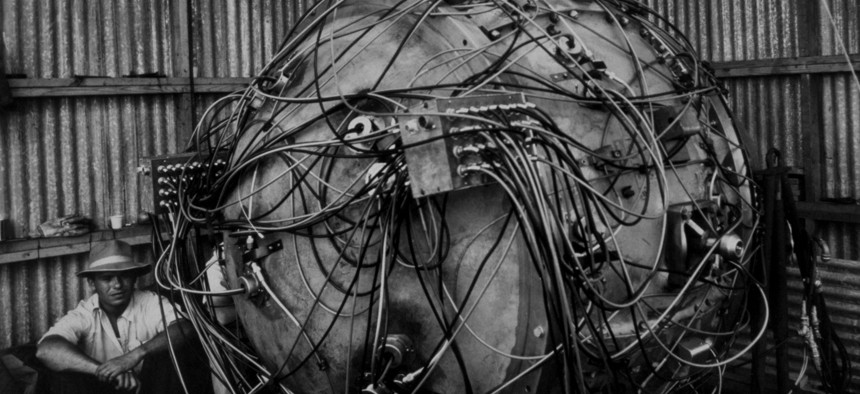
Physicist Norris Bradbury sits next to The Gadget, the nuclear device created by scientists to test the world's first atomic bomb, at the top of the test tower at the Trinity Site in New Mexico, 1945. Historical / Getty Images
GAO: Army Corps’ cleanup of Manhattan Project-era sites suffers from management, cost uncertainties
Although the U.S. Army Corps of Engineers’ cost estimate of contaminated sites associated with the early decades of nuclear weapons manufacturing sat at $2.6 billion at the end of fiscal 2022, that number could easily grow substantially over time.
A federal government watchdog on Tuesday found that the U.S. Army Corps of Engineers could do more to improve cost estimates and otherwise manage the cleanup of nearly 20 locations associated with the development and manufacture of nuclear weapons.
The Army Corps’ Formerly Utilized Sites Remedial Action Program, or FUSRAP, is a program for the identification and eventual cleanup of locations with hazardous materials or other contamination stemming from the sites’ prior use as part of the Manhattan Project and the early manufacture of nuclear weapons. There are currently 19 active sites, mostly in the Midwest and Mid-Atlantic, of which eight are situated in or near underserved or otherwise impoverished communities.
In a report released Tuesday, the Government Accountability Office found that the Army Corps needs to do more to implement tenets of program management, as well as improve its system for estimating the costs associated with evaluating and ultimately cleaning up contamination caused as a result of the United States’ development of nuclear weaponry.
The most recent estimates of the government’s “environmental liability”—the future cost of cleanup—associated with the sites covered by FUSRAP was $2.6 billion at the end of fiscal 2022. But due to how the U.S. Army Corps of Engineers calculates that figure, the true cost to remediate contaminants could be much higher.
Rather than creating an exhaustive cost estimate, the agency creates an environmental liability estimate when a new site is added to FUSRAP, which includes the projected cost to investigate a facility and conduct feasibility studies for remediation. Once those studies are complete, the Army Corps then updates the liability estimate to include the “lowest-cost estimate of the acceptable cleanup alternatives” listed in the feasibility study. And once the agency has chosen which cleanup option it wishes to take, the figure is updated again.
That process means that the environmental liability estimate is prone to sizeable increases over time. Between fiscal 2016 and fiscal 2022, the estimate has grown by 63%, or nearly $1 billion. Corps officials told GAO that half of that increase is attributable to inflation, while the other half can be chalked up to “cleanup-related uncertainties,” including both the way that the agency iteratively estimates the costs of a cleanup project as well as instances where, during a cleanup, officials found more extensive contamination than previously anticipated.
GAO argued that a more comprehensive estimate of the costs of a project over its entire life cycle could allow the Army Corps to better track cost changes and develop strategies to mitigate uncertainties.
“The environmental liabilities estimate is not an integrated life cycle cost estimate because it does not include all program expenditures, including costs from previous years, costs for potential sites and certain other monetary flows,” the report states. “By not including costs from previous years in the life cycle estimate, the Corps does not have a complete picture of the total cost of FUSRAP . . . Their exclusion limits the program’s ability to track how costs change over time and better understand the magnitude of changes in relation to total program costs.”
GAO also found that while the Army Corps of Engineers requires individual offices to follow top practices associated with program management, the same is not true at the departmental level, which could lead to inefficiencies.
“For example, the section on FUSRAP’s acquisition strategy does not identify program-wide strategies, such as how FUSRAP will share contracting support staff to ensure that securing cleanup contracts does not delay site timelines,” GAO wrote. “Instead, it states that acquisition strategies will be developed at the division and district level. Corps officials said that the availability of contracting staff varies by district, with some districts, such as Buffalo, having dedicated contracting staff. In contrast, the New York and Philadelphia districts rely on contracting staff in other districts, and it can be difficult to get contracting support, according to Corps officials.”
Better program management, GAO argued, could also help the Corps identify staffing issues more quickly and avoid project-level delays caused by a lack of available contracting or health physicists and other technical experts.
GAO recommended that the secretary of the Army ensure that the Army Corps of Engineers update its FUSRAP program management plan to “follow leading practices” on the topic, create a program-wide roadmap of future actions, as well as revamp its process for developing and updating cost estimates to cover the entire life cycle of a cleanup project. The Defense Department concurred with each of the report’s recommendations.







